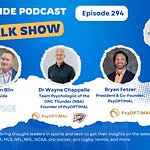Dear colleague,
This week I sat down with David Daoud, CEO of Compliance Standards to share my thoughts on on how elite teams vet sports tech startups, on the common mistakes made by startups. We also discussed the world of elite sports which is based on relationships. We also touched on the tech budget side of teams, and the need to get internal champions to successfully do pilots with teams. We also touched on what makes a strong founder in the eyes of teams.
You can listen to the audio interview by clicking on the above button or just watch the full video interview by clicking on the Youtube video below. You can also check out the best quotes of the interview in the section below.
📝Show Notes: Through this interview, we touched on:
On how teams usually vet startups
On why the Sports tech market feels saturated
On what teams actually look for
On the reality behind the “10,000 Sports tech startups” number
On how small the buyer side really is
On the importance of trust, tools, and vetting
On traction vs. innovation
On how Startups can stand out and win
On athlete investors and their role in startups
On startup intent and founder mentality
Best,
You can read the full transcript of the interview located at the top of this blog post.
Here are below the best quotes from the interview:
💡 On How Teams Usually Vet Startups
“It really depends on the team. Some teams have internal people — like a head of tech or innovation — who are tasked with scouting and vetting vendors. Others rely more on external support, like what we do at Upside. In general, the performance and medical staff are stretched thin. They’re in the weight room, the rehab room, traveling with players — they don’t have time to research 20 vendors. That’s why they appreciate platforms like ours that simplify comparisons — pricing, specs, scientific evidence, customer base — all in one place.”
“Some teams are excited by new technology and want to see everything. Others are cautious — they won’t even take a meeting unless there’s peer-reviewed research or published studies. I know teams that won’t touch a product unless it’s already been validated by someone they trust or a leading academic institution. It’s all about risk management.”
“Also, some teams are open to working with early-stage startups — even giving feedback, co-developing features, or doing small pilot studies. But many others just want to buy a commercialized product that’s ready to go off the shelf. They don’t want to spend months helping a company refine a prototype. That’s the reality — not all teams are willing to be a test case.”
“And finally, teams talk to each other. Word of mouth is huge. If one high-performance director had a bad experience with a vendor, that spreads quickly. So as a startup, your credibility, transparency, and how you handle relationships matters just as much as your tech.”
💡 On Why the Sports Tech Market Feels Saturated
“I think what’s really driving the boom is that people just love sports. That’s the core of it. You’ve got so many engineers, former athletes, and founders who are fans first and entrepreneurs second — and they want to work with teams. So they start something. But here’s the catch: there are now over 10,000 sports tech companies worldwide, and a large portion of them are just one or two people — with a single product, often no funding, and sometimes no customers at all. They might be bootstrapping it, building prototypes on their own dime. And when they try to get in front of elite teams? It’s tough. It’s really hard to break in. You’ve got to hit a home run right away — if you don’t show up with a solid product, a clear value proposition, and something that immediately resonates with that team’s needs, you probably won’t get a second meeting. The market might look big, but when you actually try to sell into it, it’s a tight funnel — and the bar is very high.”
🧠 On What Teams Actually Look For
“It’s not necessarily a red flag if a company only has one product — that’s not the issue. What matters is whether the product is good. Does it do what it’s supposed to do? Is it backed by peer-reviewed research? Is there solid validation? And most importantly — do you have teams using it today and seeing results? For example, I interviewed a company like Output Sports. They’ve got one sensor, but it’s connected to a software platform that’s constantly being updated, providing more insights and new algorithms over time. Teams are fine with that. They don’t need you to have ten SKUs. They want confidence that the product works and the data is trustworthy. If that’s there, you’re in the conversation.”
⚖️ On the Reality Behind the “10,000 Sports Tech Startups” Number
“Look, I’ve been in this space for over a decade. And it’s true — there are now 10,000 companies that call themselves sports tech startups. But I would argue that a huge portion of those are not truly scalable businesses. Some of them are husband-and-wife teams building something on weekends. Some are what I call lifestyle startups — the founder is using the startup to travel, attend conferences, meet cool people. There’s nothing wrong with that, but that’s not the same as building a company that can scale globally. What I’m looking for — and what elite teams care about — is: do you have a real business model? Are you raising capital? Do you have case studies and traction? If not, you’re just part of the noise, not part of the future.”
🏢 On How Small the Buyer Side Really Is
“People assume that because they’re selling to a famous club — the Lakers, the Patriots, FC Barcelona — that there must be these huge departments making decisions. That’s not the case. These are small teams. In the performance department, you might have five to fifteen people — that’s it. You’ve got your head of performance, a couple trainers, a physical therapist, maybe a dietitian or nutritionist, sometimes an in-house developer or data analyst, but not always. So as a vendor, you’re not selling into IBM — you’re selling into a really lean, hands-on, time-strapped unit. And they don’t have time to vet 50 companies or sit through endless demos. They’re busy working with athletes all day. That’s why they need help finding the right solutions — and why relevance, speed, and clarity matter so much more than hype.”
🧰 On the Importance of Trust, Tools, and Vetting
“Teams don’t always have the time or resources to vet every product that hits their inbox. That’s why at Upside, we’ve built a platform where they can compare vendors instantly — pricing, specs, scientific backing, customer base — in one place. It’s launching during our dinner at the NBA Summer League. The idea is simple: give performance directors and trainers the ability to cut through the noise in 60 seconds. They don’t want to dig through 20 websites. They want to know what works, how much it costs, and who else is using it. And most importantly — is there proof that it delivers results? If we don’t build tools like this, teams will keep drowning in options without clarity.”
🧬 On Traction vs. Innovation
“You can have the most innovative product in the world, but if you don’t have customers — if you don’t have traction — most teams won’t touch it. They want to know: is this real? Has someone else used it in a real environment, in competition or during rehab, and seen results? You also have the opposite: companies with huge marketing budgets and traction but no innovation. That’s not ideal either. The sweet spot is when you’ve got something new, but it’s validated — scientifically and commercially. Teams are cautious for good reason. They don’t want to be guinea pigs. And they’ve been burned before. So unless you’ve got proof and a plan, it’s hard to break through.”
🔍 On How Startups Can Stand Out and Win
“If I had to lay it out clearly for a startup founder, here’s what I’d say: First, make sure your product is commercial-ready — not just a prototype. Second, back it with science — real studies, not just internal testing. Third, get your first paid customer — not a free trial, not a test, but someone actually paying. Fourth, find athlete ambassadors who elevate your brand. And fifth, get repeatable sales. Investors care about recurring revenue, because that’s what leads to sustainable growth. And don’t just build — promote. Speak at conferences, publish case studies, get on panels, show thought leadership. Be the expert, not just the engineer. That’s how you separate yourself from the other 9,999.”
🧑💼 On Athlete Investors and Their Role in Startups
“It’s incredibly common now to see athletes investing in startups. They know their playing careers are short — and many of them are already planning their post-sport careers while still on the court. I interviewed Thaddeus Young — he’s invested in over 200 startups through his family office. He told me his goal is to make as much money after basketball as he did during his playing years. And that’s the mentality. But it’s not easy for startups to get access to those athletes. And even when they do, there’s negotiation. Some athletes want equity in exchange for exposure, others want to invest actual capital. It depends. But overall, yes — athletes are absolutely active in the ecosystem as advisors, investors, even co-founders in some cases.”
🧭 On Startup Intent and Founder Mentality
“There’s a huge difference between startups trying to build something big and startups that just want to have fun. I’ve seen founders who treat it like a side hustle — something that pays for their trips to Dubai or Barcelona, maybe gives them a reason to say ‘I work with Barcelona’ or ‘I met with the 49ers.’ But they have no intention of raising money, building a team, or scaling globally. That’s fine — but teams need to know that. Because if they adopt a product and the company disappears 12 months later, that’s risk. Serious founders are raising capital, building structure, hiring teams. They’re in it for the long run. And that’s who teams — and investors — want to work with.”
You may also like:













